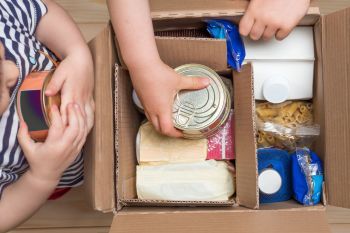HOW CAN LOCAL AUTHORITIES CREATE MEANINGFUL ACTION TO REDUCE FOOD POVERTY?
Posted on
by NHD guest blogger, Farihah Choudhury, ANutr
 The COVID-19 pandemic has brought to the fore the proliferation of food insecurity across the country, as people have unexpectedly lost employment and experienced curtailed access to support networks over the past 18 months. As a result, food poverty sharply rose in 2020, following the trend of the rapid growth of emergency food aid initiatives and food poverty over two decades.
The COVID-19 pandemic has brought to the fore the proliferation of food insecurity across the country, as people have unexpectedly lost employment and experienced curtailed access to support networks over the past 18 months. As a result, food poverty sharply rose in 2020, following the trend of the rapid growth of emergency food aid initiatives and food poverty over two decades.
Whilst food banks are a poor proxy measure of food insecurity (as most people experiencing food insecurity do not access food banks for a multitude of reasons),1 they paint the trend and urgency of the food poverty situation tellingly. The first Trussell Trust Foodbank was established in Salisbury in 20002 – today they operate over 1300 foodbanks,2 which is two thirds of the UK total. However, despite food aid skyrocketing, poverty has not decreased.
There is an urgent need now for local authorities to build action on food poverty into their strategy, usually delivered through Public Health teams working with partners across councils and other organisations in the locality, which many have begun to explore and establish. Sustain, the alliance for better food and farming, has developed extensive resources to support councils to deliver action on food poverty and suggest targeting several areas. I summarise some key actions below:
1. Improving Healthy Start Voucher uptake
The Healthy Start scheme is a UK food welfare scheme designed to help families on low income with access to fresh fruit and vegetables, milk and vitamins for free. However, nationally, only 57.8%3 of eligible beneficiaries actually access the vouchers. The recent increase in voucher value to £4.25 (from £3.10) presents an opportunity for local authorities to work with their local NHS authority to increase uptake.
2. Promoting breastfeeding through the Baby Friendly Initiative
Supporting mothers to breastfeed infants supports lifelong good health and nutrition, as nature’s free nourishment. However, in the UK, breastfeeding prevalence at six to eight weeks is only roughly 48.2%.4
3. Ensuring children’s access to food 365 days a year
Through promoting and improving schemes like Free School Meals and the Holiday Activities and Food programme, children can be protected from going hungry. Some local authorities (and indeed geographies around the world) have taken steps to embed Universal Free School Meals, which have been shown to have a positive impact on the health of all children in the chosen setting.5
4. Supporting fair pay by promoting the Real Living Wage to the local council and employers
Food poverty is just a branch of poverty. Realistically, if someone does not have stable adequate income, food is often the first thing to be compromised, leading to hunger. Enabling and empowering families and households to access rewarding employment is important in capacity building and creating resilience against poverty, reducing and eliminating the need for reliance on food aid.
5. Ensuring all residents have access to good food
The food environment plays a huge stake in our access to adequate nutrition. Working with local shops, farms and supermarkets, as well as spatial planning departments, to ensure every household can access varied, healthy and affordable goods, is a vital step.
6. Supporting services that provide financial crisis support and advice
Many food banks now signpost to, and work with, organisations such as the Citizens Advice Bureau, to enable individuals to access benefits and advice to which they are entitled. This includes help to manage finances, as missed benefits and debt are huge contributors to not being able to afford food. Local authorities can strengthen these systems.
7. Developing an alliance and action plan to tackle food poverty
Leaving the most important action to last, tackling the accelerating issue of food poverty necessitates strategic partnership working, delivered in an impactful and sustainable manner. The features of an action plan can involve all of the areas mentioned above. Writing a Food Poverty Joint Strategic Needs Assessment and/or a Food Poverty Action Plan, as well as creating a Food (Poverty) Alliance, cements actions and secures accountability.
Whilst work on food poverty can seem daunting, considering the scale yet relative novelty of the problem, the majority of the actions are strengthening and linking up existing initiatives such as the Healthy Start Scheme and Free School Meals.
For a full list of actions local authorities can take to tackle food poverty, read Sustain’s guidance here: https://www.sustainweb.org/foodpoverty/measures/
Farihah Choudhury, ANutr
Public Health Practitioner, Hampshire County Council
Farihah is a Public Health Nutritionist within local government.
She is particularly interested in food policy, non-communicable diseases as
a result of changing food environments, sustainable diets,
and food culture and anthropology.
Twitter@: farihahchdhry
Instagram: easypeasysustainablenutrition
Website: easypeasysustainabilitynutrition.co.uk
References
- Food Foundation (2016). Measuring Household Food Insecurity. http://foodfoundation.org.uk/wp-content/uploads/2016/07/MeasuringHouseholdFoodInsecurity.pdf
- House of Commons Library (2021). Food Banks in the UK. https://commonslibrary.parliament.uk/research-briefings/cbp-8585/
- NHS UK (June 2021). Healthy Start uptake data. https://www.healthystart.nhs.uk/healthcare-professionals/
- Public Health England (2020). Breastfeeding prevalence at 6-8 weeks after birth (Experimental Statistics). https://assets.publishing.service.gov.uk/government/uploads/system/uploads/attachment_data/file/880354/2019_2020_Q3_Breastfeeding_Statistical_Commentary_FINAL.pdf
- Sustain (2021). Newham Council to keep ‘Eat for Free’ universal free school meals for ALL primary school pupils. https://www.sustainweb.org/news/jan21-newham-keeps-fsm-all-primary-pupils/
